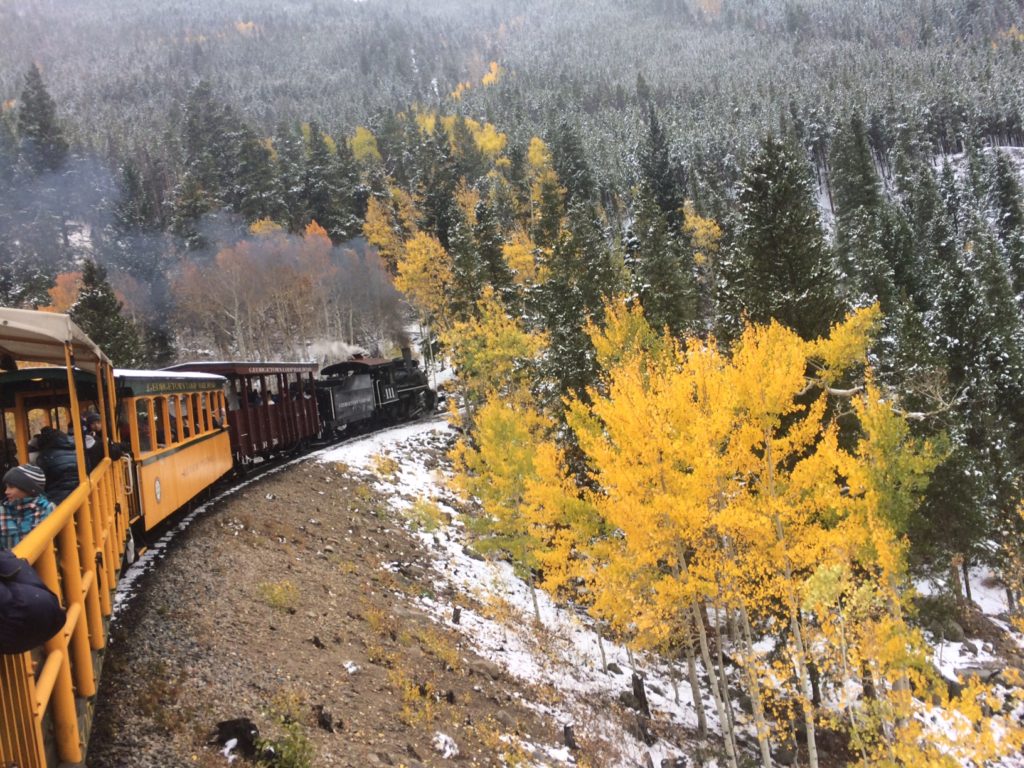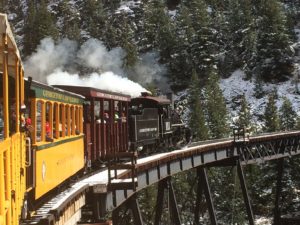 The air is brisk on my cheeks as I sit on the wooden bench. I lean out over the side, hoping for a glimpse of the golden Aspen trees. Instead I am hit with a whoosh of cinders as black smoke spews out the top of the engine.
The air is brisk on my cheeks as I sit on the wooden bench. I lean out over the side, hoping for a glimpse of the golden Aspen trees. Instead I am hit with a whoosh of cinders as black smoke spews out the top of the engine.
It is a glorious day with the fresh snow on the ground providing a backdrop for the spritz of yellow and a peek of blue sky here and there as the clouds part.
As the train slowly moves up the track, I feel as if I am stuck in an endless loop as the train keeps banking around curves. We weren’t just here? Are we making any progress at all towards Silver Plume? I notice a woman across from me wearing flip flops — she must be freezing. The rest of us are bundled up as if it is the dead of winter. And it feels that way as we arrive at Silver Plume to snow falling and a brisk 28 degrees. Still it’s great to be going back in time to experience mining times from over a century ago.
Back in the mining heyday in Colorado, many railroads were constructed throughout the state to move mining supplies, miners as well as ore. The terrain of the mountains is so steep and rugged, it necessitated building a different type of railroad — a narrow gauge. Built with the rails a mere 3 feet apart, narrow gauge railroads were able to navigate the many curves necessary to scale the mountains and at a much cheaper costs. At one point, narrow gauge railroads criss-crossed the state. But just a few survived through the 20the century — the Georgetown Loop is one of those. 
The Loop literally loops back around, crossing trestle bridge making it way up the canyon to the small town of Silver Plume. Today, tourists ride the Loop to experience fall foliage on open air cars and for a select few, an enclosed parlor car. We are not one of those select few, so are riding exposed to the brisk temperatures.
We head back towards Georgetown, but make a stop along the way to tour the Lebanon Silver Mine. Donning our hard hats (who looks good in a hard hat), we follow our guide deep into the mountain side, following tracks as we go. At one point, our guide points out the raw silver ore still emanating from the rocks inside.
Somehow actually touring a mine tunnel really brings home what a brutally hard life the 19th-century miners had. Working 12-hour days in 42-degree temperatures, swinging hammers and picks, blasting dynamite and hauling rock into the ore carts. The dust they inhale is filled with silica, literally fine microscopic particles of glass that gives them lung disease.
Even the children weren’t exempt from mining, with mine operators employing them for various tasks like placing the dynamite in the drilled holes, before nimbly scurrying off. For this task and others, they receive a grand total of 75 cents per day and a fun nickname — “powder monkeys.” They also the get the dubious job of hauling out the poop of miners in blasting boxes — dubbing another nickname — the “necessary box.”
Finally our tour is over and we climb back up the hill to board our train for the final stretch. Memories of the chug-a-chug of the train mixed with the beautiful fall scenes of snow and yellow Aspens bring a smile to my face.

